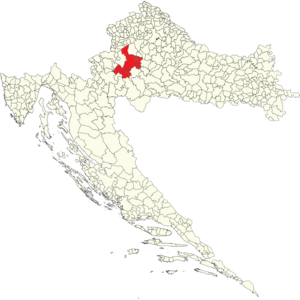
Electoral district I (Croatian : I. izborna jedinica) is one of twelve electoral districts of the Croatian Parliament.

Electoral district I (Croatian : I. izborna jedinica) is one of twelve electoral districts of the Croatian Parliament.
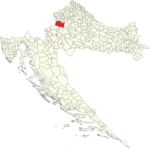
Electoral district I consisted of: [1]
Under 2023 revision district boundaries were redrawn according to suggestion of Constitutional Court to compel proportional number of voters.
New district consist of:
|
|
| |||||||||||||||||||||||||||||||||||||||||||||||||||||||
|
| |||||||||||||||||||||||||||||||||||||||||||||||||||||||||||||||||||||||||
|
|
| ||||||||||||||||||||||||||||||||||||||||||||||||||||||||||||||||||
|
|
| ||||||||||||||||||||||||||||||||||||||||||||||||||||||||||||||||||
| SDP - HNS - HSU - HL SR - A-HSS - ZS
| HDZ - HSS - HSP AS - BUZ - HSLS - HRAST - HDS - ZDS
| ||||||||||||||||||||||||||||||||||||||||||||||||||||||||||||||||||
|
|
| ||||||||||||||||||||||||||||||||||||||||||||||||||||||||||||||||||||||||
|
SDP - HSS - HSU - SNAGA - GLAS - IDS - PGS
| Možemo - ZJN - NL - RF - ORAH - ZG
DP - HS - BLOK - HKS - HRAST - SU - ZL | ||||||||||||||||||||||||||||||||||||||||||||||||||||||||||||||||||||||||||||||||||||
|
SDP - Centar - HSS - DO i SIP - NS R - GLAS
|
| ||||||||||||||||||||||||||||||||||||||||||||||||||||||||||||||||||||||||||||||

Trnje is a district in the City of Zagreb, Croatia. According to the 2011 census, the district had 42,282 residents. It is located in the central part of the city, south of Donji grad across the railway, east of Trešnjevka, west of Peščenica, and north of the river Sava. The Slavonska Avenue intersects Trnje.
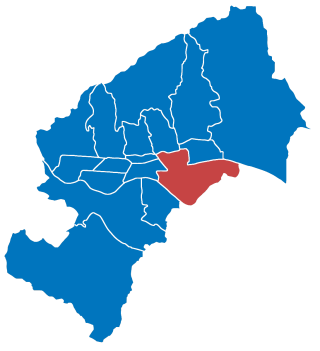
Peščenica – Žitnjak is a city district in the southeastern part of Zagreb, Croatia. It consists of two parts: Peščenica, a set of neighborhoods; and Žitnjak, a large industrial zone on the city outskirts, and has a total population of 56,487.

Maksimir is one of the districts of Zagreb, Croatia, population 48,902. Maksimir stadium and Maksimir Park are located in it. It was named for Bishop Maksimilijan Vrhovac.

Črnomerec is one of the city districts of Zagreb,Croatia. Original name was Črnomerec kod Pitona. It is located in the western part of the city and has nearly forty thousand inhabitants.

Donji grad is one of the 17 city districts of Zagreb, the capital of Croatia. It is located in the central part of the city and has 37,024 inhabitants. The official name of the district is rarely used, for it is dubbed centar (center) by most Zagreb residents even though "centar" encompasses some southern parts of district Gornji Grad-Medveščak.

Gornji Grad–Medveščak is one of the districts of Zagreb, Croatia; Gornji Grad translates as "Upper Town", referring to its historical location on city's hillside, being above Donji Grad. The district is located in the central part of the city and, according to the 2011 census, it has 30,962 inhabitants spread over 10.19 km2 (3.93 sq mi).
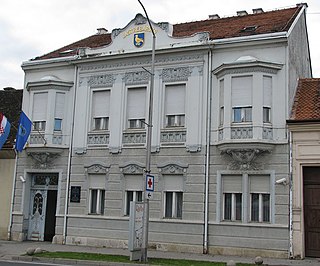
Jastrebarsko, colloquially known as Jaska, is a town in Zagreb County, Croatia.
The Nova Ves is a historic street north of the Kaptol neighborhood in Zagreb, Croatia. It is administratively within the bounds of the Gornji Grad - Medveščak city district. According to the 2001 census, the street and its surrounding area had 3,456 inhabitants. In 2009, it had a population of 3,575. From the first habitation to date, the street has had a rich history as an important part of Zagreb ever since the beginnings of the modern city.
The history of Zagreb, the capital and largest city of Croatia, dates back to the Middle Ages. The Romans had built a settlement, Andautonia, in present-day Ščitarjevo. The name "Zagreb" was first used in 1094 at the founding of the Zagreb diocese in Kaptol, after the Slavs had arrived in the area. Zagreb became a free royal city in 1242. It was made the capital of Croatia in 1845 and elected its first mayor, Janko Kamauf, in 1851. According to the 2011 Croatian census, Zagreb had 792,875 inhabitants and was also Croatia's largest city by area.
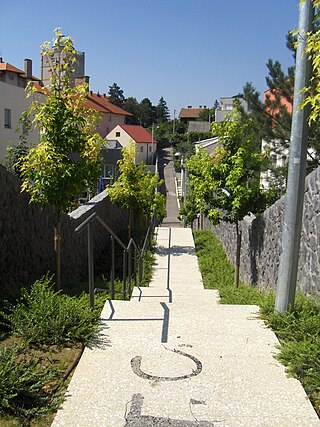
Šalata is an upper-class residential neighborhood in Zagreb, Croatia. It is administratively part of the Gornji Grad - Medveščak city district in the northern part of Zagreb and it has a population of 1,929.

Eugen Kvaternik Square is a square located on the border between Maksimir, Gornji Grad - Medveščak and Donji Grad city districts of Zagreb, Croatia. Named after Eugen Kvaternik, a 19th-century politician, it marks the intersection of Vlaška Street, Dragutin Domjanić Street, Maksimirska Street, Vjekoslav Heinzel Avenue, and Šubićeva Street. Kvaternik Square is one of the most frequented squares in Zagreb.
Stara Peščenica is a neighborhood located in the northwestern corner of the Peščenica – Žitnjak administrative city district of Zagreb, Croatia. It is bordered by Zvonimirova Street and the J. F. Kennedy Square on the north, Budakova Street on the east, railway on the south and Vjekoslav Heinzel Avenue on the west. It has a population of 5,700 (2011).
Elections were held on 15 May 2005 in Zagreb, the capital of Croatia. Following the last local elections in 2001, Milan Bandić of the Social Democratic Party of Croatia (SDP) had been re-elected as the mayor of Zagreb. In 2002, an incident made him resign in favor of Deputy Mayor Vlasta Pavić, also from the SDP. Pavić remained formally in control of the city until 2005. In the 2005 elections, she was moved down the list of candidates to the 16th place, while the list holder and SDP's candidate for mayor was Bandić.

Tkalčićeva Street is a street in the Zagreb, Croatia city center. Extending from the vicinity of the central Ban Jelačić Square to its northern end at the Little Street, the street flows between the Gornji Grad in the west and Nova Ves in the east. The street is administratively within the Gornji Grad–Medveščak city district, constituting the former "August Cesarec" commune.
The Croatian Parliament electoral districts are the special territorial subdivision of Croatia used for the country's parliamentary elections.
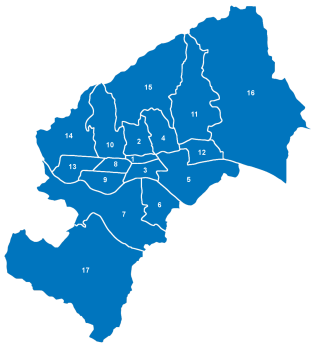
Zagreb is split into seventeen administrative divisions called city districts. The city district, along with a local committee, is a form of local self-government in the City of Zagreb through which citizens participate in the decision-making process in self-governing areas of the City and local affairs that directly affect their lives. The city district is established for an area that represents urban, economic and social entity, which is linked to the common interests of citizens. The current division was established by the Statute of the City of Zagreb on 14 December 1999. Legally, a city district is a legal person who has its own governing bodies.
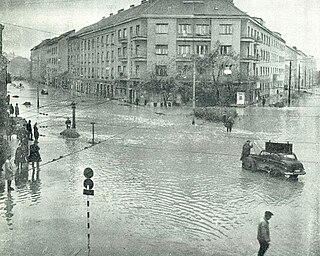
On 25 October 1964, a devastating flood of the River Sava struck Zagreb, SR Croatia, SFR Yugoslavia. High rainfall upriver caused rivers and streams in the Sava catchment basin to swell and spill over their banks in many places throughout Slovenia and northern Croatia. The worst of the flooding occurred in Zagreb. Sava floods were a known hazard in the city, having affected the development of the area since the Roman times, and the 1964 flood did not have the largest extent. However, it occurred following several decades of large-scale industrialisation and urban growth which had caused the city to expand into the most flood-vulnerable areas. The quality of building construction and flood defences in the floodplain was mostly low. Regulation of the Sava and its tributaries upriver from Zagreb cut off many natural detention basins, such as fields and pastures, which caused water to pile up ahead of the city. To make matters worse, the soil was already saturated from a mid-month episode of fairly high rainfall. A second episode of high rainfall, during 22–25 October upriver in Slovenia, produced a record-high water wave in the Sava. At Zagreb's Sava River gauge, the water crested at 514 cm above zero level, exceeding the previous high water mark by more than half a metre (2 ft). This proved too much for the city's embankments. Around 60 km2 (23 sq mi) of the city was flooded, including most neighbourhoods on the western side of the floodplain.

Electoral district II is one of twelve electoral districts of Croatian Parliament.
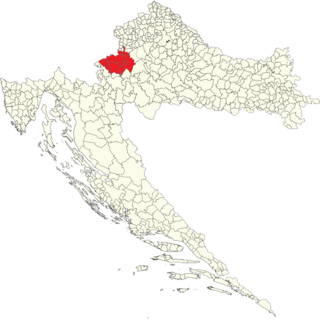
Electoral district VI is one of twelve electoral districts of Croatian Parliament.